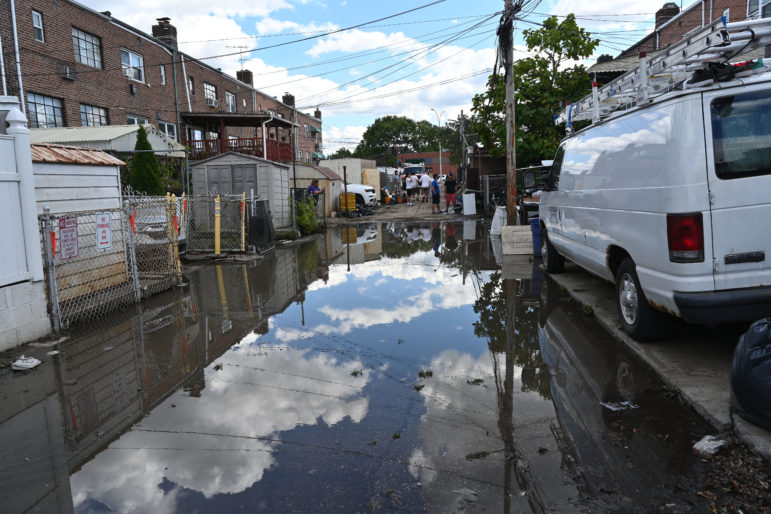The city activated its flash flooding alerts 13 times so far this year, and nine times last year, according to John Scrivani, commissioner of the city’s Department of Emergency Management Department.

Kevin P. Coughlin / Office of the Governor
Flooding in Queens following Hurricane Ida.City officials met Tuesday in an interagency hearing to discuss failings in preparation for the remnants of Hurricane Ida, which led to massive flash flooding that killed over a dozen people in New York City alone earlier this month and brought the subway system to a halt.
In the more than three-hour meeting, City Council members heard from officials with the Department of Environmental Protection, the Department of Sanitation, the office of Emergency Management, the Mayor’s Office of Climate Resiliency and the MTA, among others, about what went wrong and what the city plans to do in advance of another catastrophic event.
“Severe weather events like this one, and the other flooding events we have seen in the city this summer, are our new normal,” said Ydanis Rodriguez, who chairs the Council’s transportation committee. “We need to get to work now on adapting our city for a rainier future.”
Among the many topics discussed were management of the subway system, which became overwhelmed during the rapid rainfall.
The MTA was planning for Hurricane Ida two days before the storm hit, according to testimony from Demetrius Crichlow, vice president of New York City Transit’s Department of Subways.These efforts involved sending pumps and barriers to stations that have previously flooded, and deploying maintenance crews.
During the storm, six trains with more than 100 people were struck in stations for hours, requiring emergency evacuation, although no passenger injuries were reported. The MTA removed 75 million gallons of water from its system following the storm.
NYPD Chief Raymond Spinella said that in the future, he would consider having NYPD officers staged at locations that have experienced historical flooding and potentially closing those stations.
The MTA previously spent $2.5 billion on resiliency efforts following Superstorm Sandy in 2012. But Crichlow pointed out many of those improvements were in areas affected by coastal flooding, not flash flooding, a point Gov. Hochul made during an earlier press conference about the storms.
The Sept. 1 flooding highlights how many of the city’s recent efforts to bolster communities focused on those coastal and low-lying areas. City officials have said they were caught off-guard by the sudden, rapid and record-breaking rainfall that Ida brought, overwhelming the sewer system in a number of inland neighborhoods—what Mayor Bill de Blasio called a “whole new world” of extreme weather—though experts say meteorologists predicted the downpours.
The city activated its flash flooding alerts 13 times so far this year, and nine times last year, according to John Scrivani, commissioner of the city’s Department of Emergency Management Department.
Crichlow said that the MTA spent more than $16 million in efforts to mitigate flash flooding at 25 stations around the city. “Prior to Ida’s historic rainfall, these efforts have proven to be quite successful, with significantly fewer annual train delays due to heavy rains since 2008,” he said.
Crichlow also said that the MTA’s new acting Chair and CEO Janno Lieber reactivated an interagency special task force on flash flooding and made non-coastal flooding of the subway a top priority. “The focus will be on keeping storm waters out of our system through improved drainage along the streets and in sewers,” he said.
But the city’s sewer system also needs to be improved in order to fully mitigate the problem.
“The subway system is not a submarine,” he said. “It cannot be made impervious to water. It’s also not a sponge.”
Justin Brannan, who chairs the committee on resiliency and waterfronts, said the city’s sewer system can handle no more than 1.5 to 2 inches of rain per hour, less than half what fell in one hour during the storm.
“The sewer system, which was built 100 years ago, is not designed for the once in a lifetime storms that we now get several times a year,” he said.
He added that the city’s stormwater resiliency plan, released in May, is a good first step to protecting the city from intense storms, but that some projects will take up to two years to complete.
“The climate crisis is here,” he said. “The time for discussion is over. And now it’s time to prioritize and expedite shovels in the ground.”










2 thoughts on “At Storm Resiliency Hearing, Officials Look to Prepare City and Subways for a ‘Rainier Future’”
City has never considered upgrades for a 100 plus year old sewer system. Never
My NYC water/sewer charges go up every year. Just what is the NYCDEP doing with all the money we send them? The flooding a few weeks ago was all about the NYCDEP’s lack of maintenance ans not about ‘climate change’ . NYC is overbuilt at this point. We need to limit the size of high-rise residential buildings to 30 stories in Manhattan and 15 stories in the rest of the city, and also downzone most of the city.
The MTA is another agency flush with cash that can’t mange simple tasks like properly maintaining subway drainage systems.